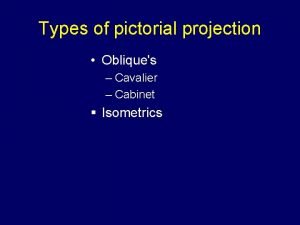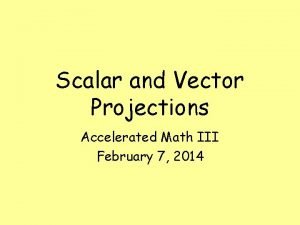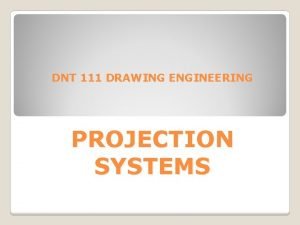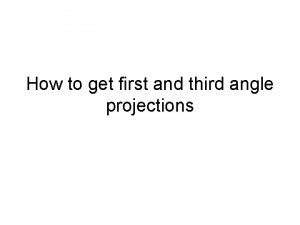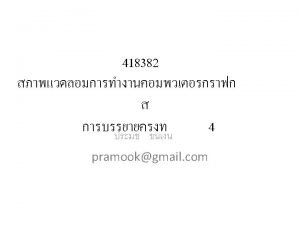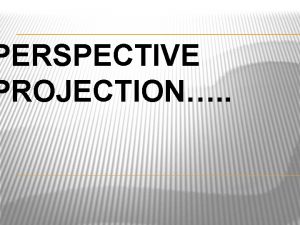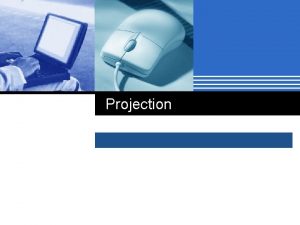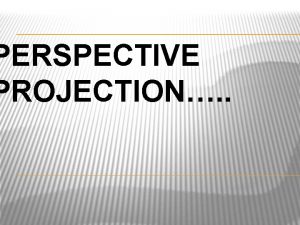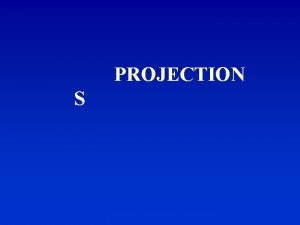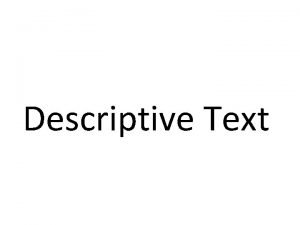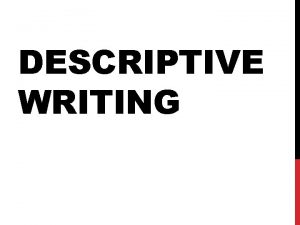Descriptive Geometry Descriptive Geometry n n The projection
















- Slides: 16

Descriptive Geometry

Descriptive Geometry n n The projection of three-dimensional figures onto a two-dimensional plane of paper in a manner that allows geometric manipulations to determine lengths, angles, shapes, areas and other quantitative information by means of graphics. Based on orthographic projections Auxiliary views are used to show true lengths and point views of lines, true size and edge views of planes, angles between two lines, between two planes and between a line and a plane. The Folding-Line Model can be used to visualize auxiliary views.

Point n n A location in space No dimension Needs three coordinates (x, y, z) to define location in space: height (below H), width (left of P), depth (behind F) Needs at least two views to show coordinates

Lines n n Straight path between two points A line can appear as: foreshortened line ¨ true-length line (TL) ¨ point ¨

Lines n n n Principal Line - parallel to at least one principal projection planes (H, F, P) Oblique Line - neither parallel nor perpendicular to any principal plane Principal Lines: horizontal - parallel to H; TL in top view ¨ frontal - parallel to F; TL in front view ¨ profile - parallel to P; TL in side views ¨

Principal Lines

True Length of a Line n n n Pythagorean Theorem True length diagram Auxiliary View of the line Pythagorean Theorem

True Length of a Line True Length Diagram

True Length of a Line: Auxiliary View n n n Line of sight needs to be perpendicular to the line But line of sight is perpendicular to the reference (or projection plane) Therefore, reference plane must be parallel to the line. The resulting view will show the TL of the line.

Direction of a Line n n Shown in the Top View Compass Bearing Angle measured from the N or S ¨ angle is between 0 and 90 degrees ¨ n Azimuth Angle measured clockwise from the north ¨ angle is between 0 and 360 degrees ¨ Line Compass Bearing AB N 25 o. E AC N 35 o. W AD S 30 o. E AE S 52 o. W Azimuth N 25 o N 325 o N 150 o N 132 o

Direction of a Line

Slope of a Line n n Measure of steepness/inclination with horizontal Can be specified using a. Slope = rise/run ¨ b. %grade = slope × 100% ¨ c. Slope angle ¨ n n Angle between the TL of the line and the horizontal plane (H). Find TL off the TV. The resulting view will show the angle between the TL of the line and the horizontal plane (corresponding to the H-ARP fold line).

Slope Angle of a Line

Point-View of a Line Procedure: n 1. Find the true length of the line a. Take a reference plane parallel to the line ¨ b. Project the endpoints perpendicular to the reference plane. Label all reference planes. ¨ c. Transfer distance away from “previous” corresponding reference plane ¨ n n 2. Take a reference plane perpendicular to TL. 3. Project and transfer. Line should be Ptview.

Edge View of a Plane - Find the Pt. View of any line in the plane. Procedure: n 1. Find a line in the plane that is shown as a TL. A. Draw a horizontal line 1 -0 on the plane in the front view. B. The line in step A is TL in the top view. The desired line of sight is parallel to the TL line. n n n 2. Take a reference plane perpendicular to the located TL. 3. The point view of line 1 -0 is found by projecting from the top view. Locate 1 by transferring the dimension H from the front view. 4. Locate points 2 and 3 by transferring their height dimensions from the front view. The plane should be EV.

 Cavalier pictorial projection
Cavalier pictorial projection Scalar and vector projections
Scalar and vector projections 3 view drawing
3 view drawing Dnt
Dnt First angle projection and third angle projection
First angle projection and third angle projection 4 electron domains 2 lone pairs
4 electron domains 2 lone pairs Bonding theories
Bonding theories Pf3 molecular geometry
Pf3 molecular geometry 101012 bằng
101012 bằng Hươu thường đẻ mỗi lứa mấy con
Hươu thường đẻ mỗi lứa mấy con Lời thề hippocrates
Lời thề hippocrates Tư thế worm breton là gì
Tư thế worm breton là gì đại từ thay thế
đại từ thay thế Quá trình desamine hóa có thể tạo ra
Quá trình desamine hóa có thể tạo ra Công của trọng lực
Công của trọng lực Thế nào là mạng điện lắp đặt kiểu nổi
Thế nào là mạng điện lắp đặt kiểu nổi Dot
Dot
